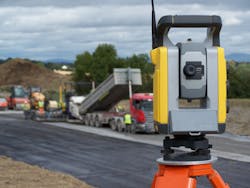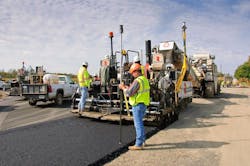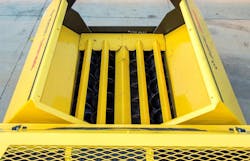Technology for Precise Asphalt Mat Placement
Probably safe to say that automated 3D grade-control systems for earthmoving applications are on their way to becoming mainstream technology. It’s technology that can, for example, automatically control the orientation of a motor-grader or dozer blade via a digital terrain model that works in concert with positioning technology, whether GNSS (global navigation satellite system), robotic total stations, or a combination of GNSS and lasers. The same basic technology began working its way into concrete paving less than a decade ago, freeing this operation from the constraints of stringline grade references. More recently, the technology has started to gain traction in asphalt paving, potentially bringing added control and efficiency to projects that can justify the cost.
Kevin Garcia, manager for paving and specialty construction in Trimble’s Civil Engineering and Construction Division, defines the basic technology of 3D control systems for asphalt pavers.
“The 3D system works by constantly referencing the trailing edge of the screed against a 3D model. The model designates where the pavement surface should be, and the machine-control system adjusts both the grade and slope of the screed, automatically, to keep it on design. Trimble’s PCS900 machine-control system, for example, uses total stations for machine guidance, considering them the most accurate method available.”
According to Mike Momrow, 3D Paving manager, Topcon Positioning Systems, the company’s 3D-MC Asphalt system uses the Topcon Millimeter GPS control concept, which combines GPS (global positioning system) receivers for location and millimeter-level lasers to fine-tune accuracy. In the past 18 months, he says, Topcon also has developed an LPS (local positioning system) that uses only robotic total stations.
Caterpillar’s Jon Anderson, global sales consultant, expands the discussion of asphalt-paver control systems.
“As a paver and screed lays down the mat, the screed conforms to a controlled depth, width, and/or cross slope. On conventional 2D systems, the paver/screed works from the ‘ground up,’ referencing the existing grade using sonics, averaging skis, or string lines, adjusting the depth and/or slope when required. Typically, the material is placed at a consistent thickness over the base.
“Basically,” says Topcon’s Momrow, “the mechanics of the 3D-paving process are 90 percent the same as in a 3D earthmoving application. The technology, at present, is more widely used in Europe and Australia than in North America, and in many European applications, automated 3D systems are steering the paver, as well as controlling screed elevation.”
At this point in the development of automated 3D control systems for asphalt pavers in North America, most are designed to automatically adjust screed elevation (depth of the mat) and cross slope, with the paver operator managing steering and the width of the screed.
“There’s some confusion about how 3D system are defined,” says Jim Holland, vice president, sales, Vögele. “Just because a 3D model is used does not mean that all three dimensions are controlled. Most 3D systems control only elevation of the screed. Vögele has two systems: One, Niveltronic Plus, controls the tow points for screed elevation, and the other, Navitronic Plus, automatically controls tow points, machine steering, and screed width for track machines. Either system interfaces with positioning systems available from major suppliers.”
Automated 3D control is a dealer-installed option for all universal- (8-foot standard screed) and all highway-class (10-foot standard screed) Super Series Vögele models, says Holland. So far, models equipped with the company’s Navitronic Plus system have been working on airport jobs—but more contractors, he says, are beginning to consider the technology.
“Contractors are recognizing the value of 3D systems, especially on projects that require placing a wide mat,” says Holland. “When paving wide, it’s difficult to reference off a stringline.
At Caterpillar, says Anderson, the company’s 8-foot models (AP500F, AP600F, and AP655F) and 10-foot models (AP1000 and AP1055F) “are 3D-ready, and Cat dealers, working with Trimble SITECH dealers, provide the infrastructure and electronics to configure the paver for 3D operation.”
According to Anderson, a number of the company’s contractor customers operating larger pavers are using 3D systems.
“It’s a good way to do applications that have traditionally required stringlines,” says Anderson. “The cost of setting, and often resetting, stringlines is eliminated by the virtual design, which reduces risk, increases efficiency, and economizes the job site.”
Anderson does, however, add a caution.
“Using 3D systems requires a fair amount of expertise and infrastructure to employ, such as setting up UTS networks, for example, so 3D is not practical for every contractor—for instance, those with smaller pavers, which would need to be equipped with hydraulics and a screed with electronic control suitable to accept a 3D control system. For others, there might be significant barriers to obtaining the expertise and infrastructure required. Sometimes, winning a bid for a large, complex project will provide incentive to make the investment.”
John Mooney, paver product manager, Volvo Construction Equipment, is of the opinion that conventional grade and slope controls, at this point at least, remain the foundation of paver control.
“These basic controls cost less than very expensive 3D systems,” says Mooney, “and in addition, the advancement of sophisticated electronics requires operators to be trained in proper operation, adding to the machine owner’s expense. The 3D technology is being pushed into the market by site-management systems and project-modeling systems. This is not necessarily a bad thing, but today, most of the industry is focused on maintenance-type paving, such as resurfacing roadways.
“The control of cross slope and depth in nearly all work being performed today is referenced from an existing surface—and if the work is well-managed with these simple controls, then 3D systems are rendered less important in the eyes of many contractors. At this point, the restrictions of cost and complexity for 3D systems point to a limited market need for 3D systems. But that said, given the way technology is developing, 3D systems that are more practical and easier to operate likely will become available soon, making crews more productive. Until then, the industry seems to be keeping a watchful eye.”
Despite what might be considered barriers to wider application of 3D asphalt paving at present, Trimble’s Garcia says that the company has seen use of its system expanding in recent years.
Regarding the adoption of 3D paving technology, Topcon’s Momrow sees a pattern similar to that of earthmoving contractors buying into automated grade-control system. A few so-called “early adopters” embraced the technology for earthmoving projects virtually as soon as it was available, then a long, slow trickle down through the contracting ranks has been taking place—with some still remaining skeptics, although their numbers are shrinking.
“Asphalt paving is difficult enough,” says Momrow, “and when you add the 3D aspect, you need good people and resources to implement it. The technology is filtering down, but it’s a slow process. Larger contractors are at an advantage, given that they have the resources to be more inviting to prospective employees who can address the technology. Smaller contractors might have to struggle with the means, methods, and personnel.
“Today, 3D technology seems to be taking hold mostly among that group of middle-size contractors who are starting to realize that the only way they can get a leg up on other mid-size competitors is to use 3D automation or advanced 2D automation. These are the companies interested in growing their businesses. You might say there’s an ‘early-adopter’ situation developing among these mid-size firms.”
Another aspect of 3D technology that contractors are considering is the most economic way to develop the required digital model. A number of larger contractors, says Momrow, have the in-house capability—surveyors, data-prep specialists, model builders—to handle the digital aspect of the process. Many mid-size contractors who recognize the potential of 3D automation, he says, are debating the modeling process, whether it’s less expensive in the long run to invest in the people and processes to handle the task in-house, or to buy those services from a vendor.



